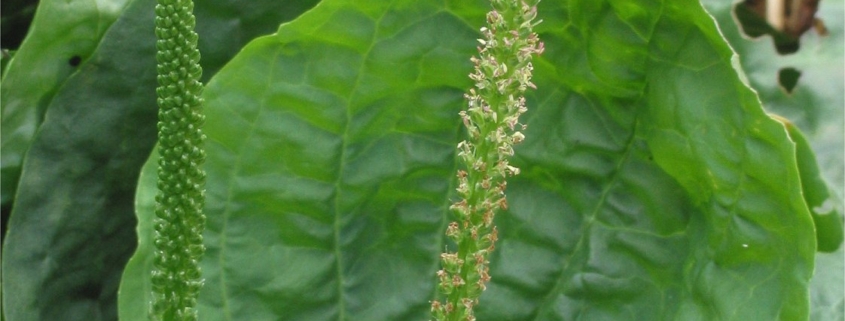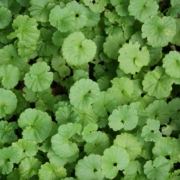Plantain
Plantain is plentifully growing everywhere in nature here in West Virginia. You can see it flourishing in yards, roadsides, fields; wherever humans create soil compaction. It’s a very easy plant to identify, its leaves have vertical striations reminding me of the rind of a watermelon. The leaves grow close to the ground in a wheel like formation and its flower heads are long, narrow, and green. This plant is my personal favorite go to first aid remedy. You can chew a few of the leaves to create an herbal poultice and apply to your skin to draw out infection and debris from the surface of a wound.
BOTANICAL NAME: Plantago major. P. laceolata
COMMON NAME(S): Narrow leaf plantain (P.lanceolata), ribwort plantain (P.lanceolata), greater plantain (P. major), psyllium (P.ovara) all 34 species of Plantago genus are edible & medicinal, white man’s foot, white man’s footsteps, English man’s foot, waybread, snakeweed, soldiers, kemps, fireleaves, ripple grass, broadleaf, cuckoo’s beard, rat tail. (Planta means ‘foot’ in Latin)
FAMILY: Plantaginaceae
PARTS USED: Primarily leaf, but also seed and root.
ENERGETICS AND TASTES: Bland, bitter, astringent, demulcent, cooling
ACTIONS AND PROPERTIES: Alterative, antibacterial, anti-inflammatory, antivenom, astringent, demulcent, diuretic, moistening, expectorant, hemostatic, vulnerary.
CONSTITUENTS: Leaf: Iridoid glycosides (2.5% including aucubin, catalpol); tannins (6.5%); polysaccharides, (galactose, xylose, arabnose, and rhamnose (E mucilage), mucilage (2%); alkaloids (plantagonine, asperuloside); flavonoids (baicalein, apigenin, scutellarin, nepetin, hispidulin, luteolin, plantagoside) (8).
Mark Pederson, author of Nutritional Herbology, writes that plantain seed is high in calcium, fiber, protein (amino acids) and fat (fatty acids, including Omega-3s) as well as silicon, sodium and zinc (4). The seed oat is made up of 30% mucilage, which absorbs toxins in the digestive tract and supports elimination by lubricating the colon (5).
DESCRIPTION: Both plantago major and lanceolata have a rosette of smooth-edged green leaves ribbed with long, parallel veins that are more prominent on the underside. Ribwort plantain (P.lanceolata) has longer, hairy, narrow leaves that taper gradually to their narrow bases and very short stalks. They have short, dense, blackish flower heads (with creaming stamens) on leafless stems. In comparison, Greater Plantain (P.major) has broader leaves which are hairless or with short hair and taper more abruptly into distinct leaf stalks which can be as long as the leaves themselves. The flower head is long, narrow and green (brown when dead). Plantago major’s flower spike extends down almost the entire length of its stem (1).
HABITAT & PROPAGATION: Plantain is native to Europe and Asia, but is naturalized throughout North America & Australia. Plantain grows in dry, disturbed and depleted soils, in short, grazed grasslands, along hedgerows and roadsides, and on waste grounds (1). Plantain is an excellent cover drop for soils harmed by extractive agriculture or repeated trampling. It is an early succession crop that thrives wherever humans create soil compaction, helping to prevent erosion, break up compaction and replenish the top soil until others can arrive.
Propagates easily by seed. Harvest the young leaves anytime of year, buy ideally in the late spring before the flower. The seed heads may be gathered when ripe.
SOLUBILITY: water, alcohol, oil
USES & INDICATIONS: Most people first come to know plantain as a first aid herb to alleviate itching and pain from bee stings or mosquito bites. It is indeed a wonderful ally for first aid including bites, cuts, scrapes, stings, rashes and puncture wounds. It soothes, cools, disinfects, staunches bleeding and speeds tissue healing. Plantain also has an extra special action of drawing infections or debris to the surface of a wound. It can help draw out splinters, stingers, venom and other poisons (think spider bites, bee stings, even snake bites-all of which contain venom). It is effective as a spit poultice, and can also be added to salves, medicated clays, or used as a wash or compress.
As a vulnerary it can help to heal tissues internally as well. I love plantain leaf as a tea/infusion for leaky guy syndrome. Its astringency and vulnerary actions help to heal the gut lining, reduce inflammation, soothe the irritated tissues through its demulcent action, and help keep the “bad” microbes in check if they are out of balance. It also makes a good tea for gastric ulcers (along with chamomile).
The demulcent action can also be helpful for constipation. Here the seed is best as it contains much more mucilage than the leaf, but the leaf can also be used in combination with other bulk laxatives or tonics for the colon. It can have a supportive role in a formula for any kind of -‘itis’, including colitis, diverticulitis, gastritis, bronchitis, cystitis, or gingivitis.
For bronchitis, it is most effective for the dry, irritated types of coughs. For cystitis, it is effective as a tea (teas are best for treating gut or kidneys), especially if it prepared as a cold infusion to extract more mucilage. This will make it more soothing to the mucosal membranes of the urinary tract. Its drawing action will exert an effect here, and it will cool, soothe, and moisten at the same time as it treats the infection. The diuretic action combined with its aucubin content supports the kidney’s production and elimination of uric acid (7).
PREPARATION & DOSAGE: For internal use, plantain can be prepared as a tea or a tincture. Hot tea is preferable when treating ailments of the digestive or respiratory tracts. Cold infusions will be more specific for kidneys and cystitis.
A wide range of dosage exists and depends on the type of ailment you are trying to treat. In acute situations, 1-2 ml of tincture or 4-6 cups of infusion per day would not be too much. To make an infusion, use 1 TBSP of dried leaves and steep at least 15 minutes, up to 10 hours.
For topical use, you can use plantain as a fresh plant poultice, infused into oil, infused in rubbing alcohol as a liniment, or prepared as a strong infusion for use as a wash or compress.
The seeds can be stirred into water or blended into smoothies as a bulk laxative.
COMBINATIONS:
- For minor cuts/scrapes/burns: plantain leaf with comfrey leaf and calendula flower infused oils.
- To stop bleeding and treat puncture wounds: plantain leaf and yarrow prepared as a wash or compress.
- For poison ivy or contact dermatitis: plantain leaf and jewelweed.
- For infections: combine with goldenseal, yarrow, and echinacea.
- For diarrhea: use seed, possibly alongside yellow dock or triphala.
- For cystitis: plantain leaf with uva ursi, marshmallow root and juniper berry.
- For bronchitis/dry coughs: use with elecampane, licorice and thyme.
- For ulcers: combine with chamomile, and/or slippery elm, marshmallow root or licorice.
REFERENCES:
- Plants and Habitats, Ben Averis
- Zevin, Igor Vilevich. A Russian Herbal: Traditional Remedies for Health and Healing. Rochester, Vermont: Healing Arts Press, 1997. Pgs.].
- “Plants in the Saxon World.” PSU Medieval Garden. Web. Accessed 10 Feb. 2017.
- Nutritional Herbology, Mark Pedersen.
- The Wild Wisdom of Weeds, Katrina Blair.
- Meteria Medica. Tehran: Tehran University of Medical Sciences; 2005. Dioscorides’s
- Tierra, Michael. The Way of Herbs. New York: Pocket Books, 1980. Pgs 179-180.
- Plantain monograph, Materia Medica Monthly produced by the Sajah Popham at the School of Evolutionary Herbalism.
This article is for educational purposes only. This information has not been reviewed by the FDA and it is not intended to diagnose, treat, or cure any disease.









